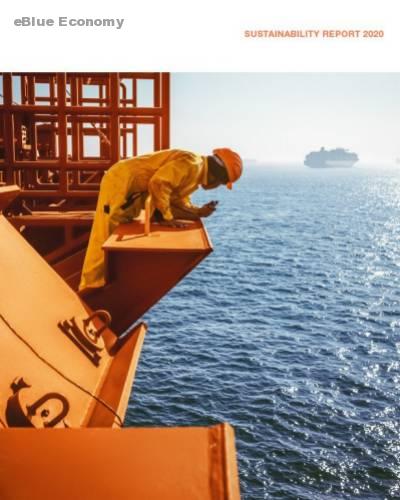-
Sulphur oxides reduced by 70% compared to the previous year
-
Additional fuel savings achieved through ship optimisations
-
New propulsion concepts tested, and state-of-the-art ships ordered
-
Focus remains on ensuring the safety and well-being of our employees
-
New sustainability strategy with concrete goals to be published later this year
Hapag-Lloyd published its Sustainability Report 2020 today and has once again made significant progress in environmental, social, qualitative and economic terms: Since the beginning of last year, Hapag-Lloyd’s fleet has been operating using IMO 2020-compliant low-sulphur fuel oil, thereby reducing its sulphur-oxide emissions by roughly 70 percent compared to 2019.
In addition, fuel savings of around 15 percent were achieved on 39 vessels by removing fouling from their outer hulls. At the same time, Hapag-Lloyd is the first shipping company in the world that has converted a large container ship to dual-fuel propulsion, which can operate using liquefied natural gas (LNG). Furthermore, in an initial test phase, biofuels based on used cooking oil were used. Moreover, orders have been placed for six state-of-the-art container ships – each with a capacity of more than 23,500 TEU – whose fuel-efficient high-pressure dual-fuel engines will also be able to operate using LNG, thereby reducing CO2 emissions by between roughly 15 and 25 percent.
These newbuilding projects geared towards sustainability have been financed by two green financing transactions, which were concluded according to the Green Loan Principles of the Loan Market Association (LMA).
Coronavirus pandemic
Owing to the coronavirus pandemic, the safety and well-being of employees had a particularly high priority during the year under review, with the result that more than 90 percent of our land-based employees were working from home at times. However, great demands were also placed on the seafarers on board our ships, as crew changes were made considerably more difficult by multiple entry restrictions and many of them had to stay on board much longer than originally planned.
For this reason, considerable efforts were also made to get them back to their families and loved ones safely and as quickly as possible.
However, the biggest challenge in the years ahead will continue to be climate change, and more will need to be invested in research and development related to propulsion concepts and fuels if we are to reach the goal of achieving climate neutrality in shipping. Shipping already accounts for 3 percent of all CO2 emissions today, and this must be further reduced in the future.
Tapping the future of shippingThat is also why our new sustainability report bears the title: “Tapping the future of shipping”. Of course, container ships are still the most efficient means of transporting large quantities of goods, including from an environmental point of view. Yet even with these efficiency-related advantages, it is clear that much more needs to be done for climate protection.
“We have made a lot of progress in all sustainability dimensions. At the same time, we are conscious of the fact that we also have a very great responsibility when it comes to climate protection. We will therefore continue to work hard to modernise our fleet and to reduce our carbon footprint.

eBlue_economy_Rolf Habben Jansen, CEO of Hapag-Lloyd.
This will likewise remain an essential part of our new sustainability strategy, which we will be publishing later this year. At its core, it is about continuously increasing our contribution to sustainability-related efforts and making incremental improvements,” said Rolf Habben Jansen, CEO of Hapag-Lloyd.
Sustainability strategy
With its new sustainability strategy, Hapag-Lloyd will set itself specific targets for the next 10 years. One was already announced in March 2021, when Hapag-Lloyd successfully placed a “sustainability-linked bond” that is connected to a clearly defined sustainability target: By 2030, the CO2 intensity of Hapag-Lloyd’s own fleet is to be reduced by 60 percent compared with 2008, the reference year of the International Maritime Organization (IMO).
About Hapag-Lloyd
With a fleet of 237 modern container ships and a total transport capacity of 1.7 million TEU, Hapag-Lloyd is one of the world’s leading liner shipping companies. The Company has around 13,100 employees and 395 offices in 129 countries. Hapag-Lloyd has a container capacity of approximately 2.7 million TEU – including one of the largest and most modern fleets of reefer containers.
A total of 122 liner services worldwide ensure fast and reliable connections between more than 600 ports on all the continents. Hapag-Lloyd is one of the leading operators in the Transatlantic, Middle East, Latin America and Intra-America trades.
Press release














